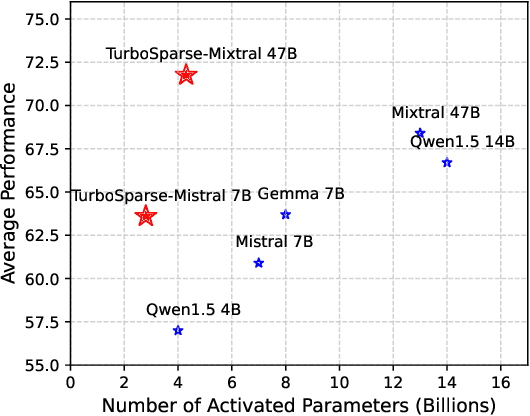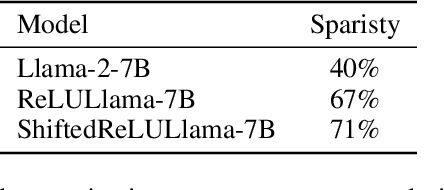Zeyu Mi
PowerInfer-2: Fast Large Language Model Inference on a Smartphone
Jun 12, 2024



Abstract:This paper introduces PowerInfer-2, a framework designed for high-speed inference of Large Language Models (LLMs) on smartphones, particularly effective for models whose sizes exceed the device's memory capacity. The key insight of PowerInfer-2 is to utilize the heterogeneous computation, memory, and I/O resources in smartphones by decomposing traditional matrix computations into fine-grained neuron cluster computations. Specifically, PowerInfer-2 features a polymorphic neuron engine that adapts computational strategies for various stages of LLM inference. Additionally, it introduces segmented neuron caching and fine-grained neuron-cluster-level pipelining, which effectively minimize and conceal the overhead caused by I/O operations. The implementation and evaluation of PowerInfer-2 demonstrate its capability to support a wide array of LLM models on two smartphones, achieving up to a 29.2x speed increase compared with state-of-the-art frameworks. Notably, PowerInfer-2 is the first system to serve the TurboSparse-Mixtral-47B model with a generation rate of 11.68 tokens per second on a smartphone. For models that fit entirely within the memory, PowerInfer-2 can achieve approximately a 40% reduction in memory usage while maintaining inference speeds comparable to llama.cpp and MLC-LLM. For more details, including a demonstration video, please visit the project site at www.powerinfer.ai/v2.
Turbo Sparse: Achieving LLM SOTA Performance with Minimal Activated Parameters
Jun 11, 2024



Abstract:Exploiting activation sparsity is a promising approach to significantly accelerating the inference process of large language models (LLMs) without compromising performance. However, activation sparsity is determined by activation functions, and commonly used ones like SwiGLU and GeGLU exhibit limited sparsity. Simply replacing these functions with ReLU fails to achieve sufficient sparsity. Moreover, inadequate training data can further increase the risk of performance degradation. To address these challenges, we propose a novel dReLU function, which is designed to improve LLM activation sparsity, along with a high-quality training data mixture ratio to facilitate effective sparsification. Additionally, we leverage sparse activation patterns within the Feed-Forward Network (FFN) experts of Mixture-of-Experts (MoE) models to further boost efficiency. By applying our neuron sparsification method to the Mistral and Mixtral models, only 2.5 billion and 4.3 billion parameters are activated per inference iteration, respectively, while achieving even more powerful model performance. Evaluation results demonstrate that this sparsity achieves a 2-5x decoding speedup. Remarkably, on mobile phones, our TurboSparse-Mixtral-47B achieves an inference speed of 11 tokens per second. Our models are available at \url{https://huggingface.co/PowerInfer}
ReLU$^2$ Wins: Discovering Efficient Activation Functions for Sparse LLMs
Feb 06, 2024Abstract:Sparse computation offers a compelling solution for the inference of Large Language Models (LLMs) in low-resource scenarios by dynamically skipping the computation of inactive neurons. While traditional approaches focus on ReLU-based LLMs, leveraging zeros in activation values, we broaden the scope of sparse LLMs beyond zero activation values. We introduce a general method that defines neuron activation through neuron output magnitudes and a tailored magnitude threshold, demonstrating that non-ReLU LLMs also exhibit sparse activation. To find the most efficient activation function for sparse computation, we propose a systematic framework to examine the sparsity of LLMs from three aspects: the trade-off between sparsity and performance, the predictivity of sparsity, and the hardware affinity. We conduct thorough experiments on LLMs utilizing different activation functions, including ReLU, SwiGLU, ReGLU, and ReLU$^2$. The results indicate that models employing ReLU$^2$ excel across all three evaluation aspects, highlighting its potential as an efficient activation function for sparse LLMs. We will release the code to facilitate future research.
PowerInfer: Fast Large Language Model Serving with a Consumer-grade GPU
Dec 16, 2023



Abstract:This paper introduces PowerInfer, a high-speed Large Language Model (LLM) inference engine on a personal computer (PC) equipped with a single consumer-grade GPU. The key underlying the design of PowerInfer is exploiting the high locality inherent in LLM inference, characterized by a power-law distribution in neuron activation. This distribution indicates that a small subset of neurons, termed hot neurons, are consistently activated across inputs, while the majority, cold neurons, vary based on specific inputs. PowerInfer exploits such an insight to design a GPU-CPU hybrid inference engine: hot-activated neurons are preloaded onto the GPU for fast access, while cold-activated neurons are computed on the CPU, thus significantly reducing GPU memory demands and CPU-GPU data transfers. PowerInfer further integrates adaptive predictors and neuron-aware sparse operators, optimizing the efficiency of neuron activation and computational sparsity. Evaluation shows that PowerInfer attains an average token generation rate of 13.20 tokens/s, with a peak of 29.08 tokens/s, across various LLMs (including OPT-175B) on a single NVIDIA RTX 4090 GPU, only 18% lower than that achieved by a top-tier server-grade A100 GPU. This significantly outperforms llama.cpp by up to 11.69x while retaining model accuracy.
 Add to Chrome
Add to Chrome Add to Firefox
Add to Firefox Add to Edge
Add to Edge